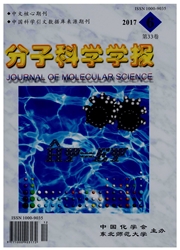

 中文摘要:
中文摘要:
朊病毒疾病是由正常构象的PrPC转化为致病构象的PrPSc引起的一类可传染的蛋白质构象病.采用分子动力学模拟的方法研究了0~500mmol/L的NaCl溶液体系对人朊病毒构象影响并深入探讨了其分子机制.研究发现NaCl可以降低朊病毒的结构稳定性,并引起其α-螺旋含量的急剧降低.进一步的研究表明高浓度NaCl溶液体系能够显著破坏朊病毒螺旋1内部的重要盐桥Asp144-Arg148和Asp147-Arg151,同时明显降低其主要氢键Arg^151 N:Asp^147 O,Tyr^150 N:Glu^146 O,Tyr^149 N:Tyr^145 O和Arg^148 N:Asp^144 O的稳定性,并诱导朊病毒的疏水核心发生明显扩张,促使朊病毒整体稳定性的下降,这些可能是NaCl促进朊病毒构象转换的重要原因.
 英文摘要:
英文摘要:
Prion disease pathology appears to be the conformational transition from PrPC to PrPSc,which is a transmissible protein conformational disease.In this study,molecular dynamics simulations were preformed to investigate the effect of 0~500 mmol/L of NaCl on the structural stability of prion.It was found that high concentration of NaCl could reduce the structural stability of prion and decrease the α-helix content obviously.Future research suggests that high concentration of NaCl could destroy two important salt bridges(Asp144-Arg148 and Asp147-Arg151) and decrease the stability of 4 major hydrogen bonds(Arg1^51N:Asp^147O,Tyr^150N:Glu^146O,Tyr^149N:Tyr^145O and Arg^148N:Asp^144O) obviously in Helix 1 of prion.Moreover,the hydrophobic core of prion was expanded obviously under the high concentration of NaCl condition.These listed factors which reduced the stability of prion might facilitate conformation transition and aggregation of prion in the NaCl solvent.
 同期刊论文项目
同期刊论文项目
 同项目期刊论文
同项目期刊论文
 Molecular dynamics simulation to investigate the impact of disulfide bond formation on conformationa
Molecular dynamics simulation to investigate the impact of disulfide bond formation on conformationa Roles of hydrophobic and hydrophilic forces on maintaining amyloid-prone cystatin structural stabili
Roles of hydrophobic and hydrophilic forces on maintaining amyloid-prone cystatin structural stabili Fluorescence spectroscopic characterization of dissolved organic matter fractions in soils in soil a
Fluorescence spectroscopic characterization of dissolved organic matter fractions in soils in soil a 期刊信息
期刊信息
